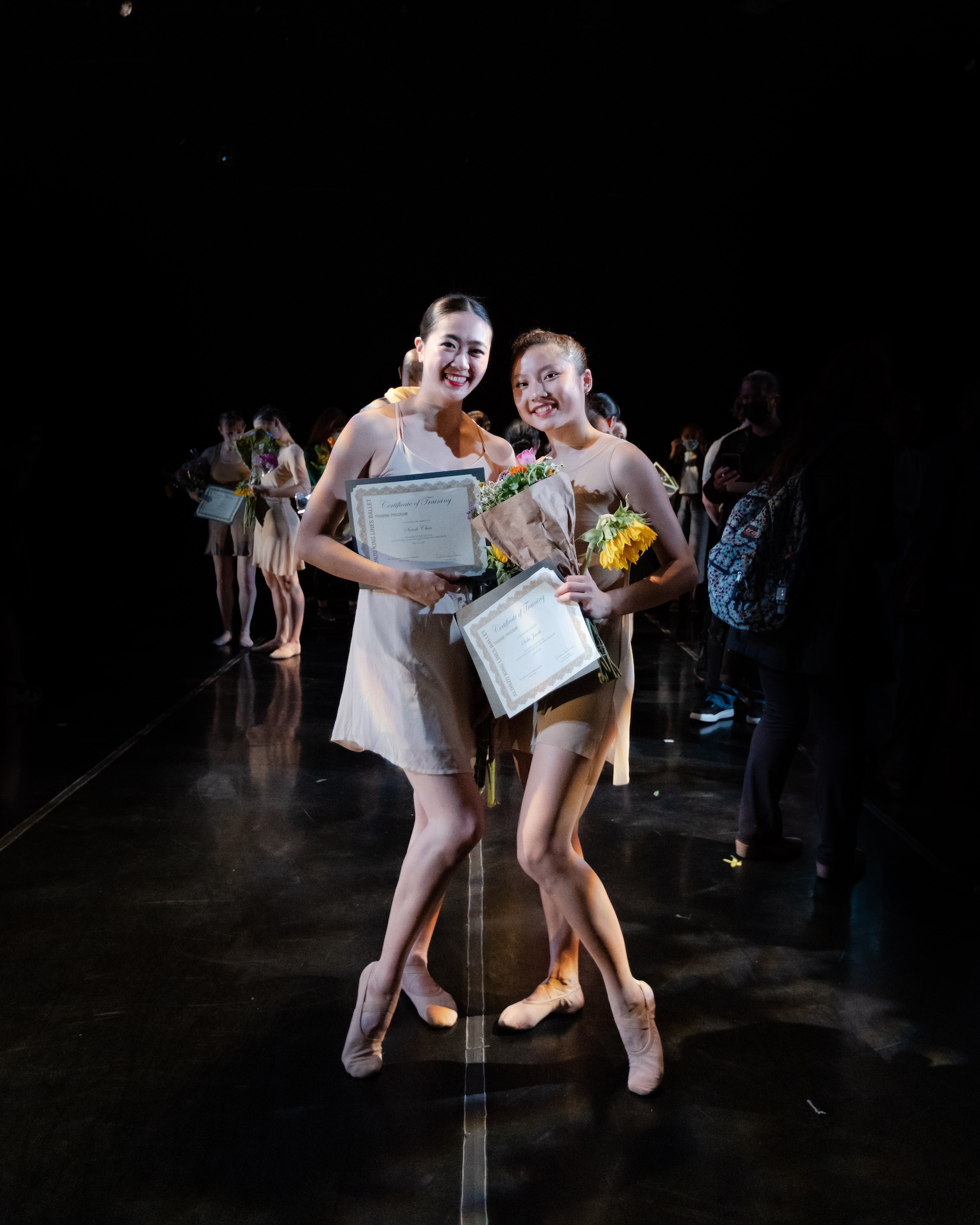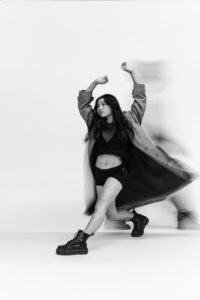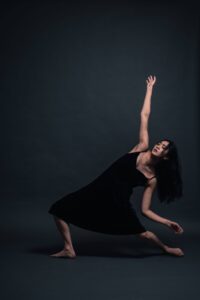
Photo by Diego Garcia
[ID: Sarah Chou and Stella Jacobs. Two dancers in nude color dresses pose onstage with flowers and certificates following a performance. They smile brightly and look directly at the camera.]
“Wow, you two look so similar!” While we get this comment a lot, and it’s an inside joke that we get to use, we couldn’t be more different. We are both Chinese-American, but the similarities stop there. Sarah stands at 5’5” with jet-black, straight, sleek hair and an aversion to floorwork. Stella is inches shorter, has wavy hair, a darker complexion, and moves completely opposite of Sarah, but somehow we are interchangeable and seen as carbon copies of each other. While we laugh at the fact that we feel obligated to provide descriptions of ourselves and shouldn’t need to explain who we are or what we look like, it proves the point that this common phrase isn’t a surface-level comment that should be brushed aside.
“It’s just so hard for me” is commonly said by a person who mixes up people of color’s names with indifference. The automatic defensiveness and shifting of blame away from themselves, and in turn towards the individual(s) incorrectly addressed, is of course reminiscent of reactions towards pointing out a racially charged (even if done unconsciously) comment: “I’m not racist; how could you say that I am?” Centering their own feelings in the aftermath of name-swapping reveals an inability to take personal responsibility. And what happens when the individual is at the front of the room, exploiting their position of power, affecting your ability to learn or even book a job? How does one approach conversations with ignorant people without sounding combative? How do we stand up for ourselves in spaces where we don’t feel safe to question anyone?

[ID: Black and white image of Stella Jacobs, a dancer in a lunge with left leg forward and both arms up. She wears a dark top and shorts along with boots and a trench coat that trails behind her.]
It’s common to make a mistake, especially when first meeting someone. The issue is how long we have known the various people who can’t seem to view us as individuals. When the two of us trained together, teachers who had us for an entire year on Zoom (with access to our names on their screens!) swapped or used one name for both of us. This bled into the second year of our training in person, still being mistaken as one despite knowing us for a year, particularly with one teacher who consistently failed to call us by our correct names. In one instance, after mixing our names up yet again, he kicked us, the only two Asian people in the studio, out. Our presence in the rehearsal was mentally “too much” for him. To quickly cover his tracks, he proceeded to randomly make others leave the room. While we were both still in shock, our peers brought this up to our school director, who forced him to apologize. Instead of taking responsibility, he asked us why it was important to call us by our correct names and said that he did not see it as a plausible concern. He lacked any type of understanding of the larger racial and historical issues involved, heavily played his white male victim card, and blamed what happened on his difficulty in remembering names. What we asked of him was simple: to correct his mistake and move on. Instead, in the studio, he overcompensated with more kindness and attention than necessary, trying so hard to convince us that he changed. We didn’t ask for special treatment; we wanted the respect that every white person inherently is given.
The offending party’s resistance is often met with feelings of guilt in those on the receiving end of the harm. We each respectively wondered, “Is this my fault in any way? Is it because our names really are so similar?” In the minutes that followed the incident, there was a constant questioning of if we cared too much, if our expectations that he call us by our names were misplaced, and what we could do to rectify the situation. In the days that followed, and even perhaps now, residual feelings of whether or not we overreacted piled on. We didn’t immediately bring this issue of name-swapping up to our director until this specific incident and only did after, in large part, because of internalized and sensitive feelings regarding our own racial identities. Decades of feeling like you have changed yourself to fit the mold that is expected of you doesn’t evaporate as soon as you learn what a microaggression is.

[ID: Set in a photo studio with a charcoal backdrop, Sarah Chou, a dancer with long black hair in a dark blue dress, is in a lunge with the right leg in front and right arm up, leaning backwards.]
The fear of being perceived as “the same as” underscores nearly all of our experiences, even if the perception isn’t expressed verbally. We know that in any dance space we will be compared to any other Asian present; the box of racial inclusion is already laid out for us to share, and the box is tiny. It manifests itself at auditions, where the thought of quotas is always a constant, wondering if, by luck and chance, there will be a spot for both of us. This fear is justified when one of us opens Instagram and sees that we are tagged in a photo, such as a solo shot from a recent event, only to discover that it’s a photo of our Asian colleague. At what point do we get to stop checking to ensure the correct person is tagged, and why does the mistake keep happening? Or when, after a performance, someone tells either of us how great we were in a certain piece, one we just so happened to not be in at all, all we can do is laugh because it happens all too often. But behind the laughter are of course deeper feelings of anger and frustration. Dancers of color should not have to think about how to differentiate themselves from others in order to be seen as individuals.
These experiences allow one, too often not by choice, to be introspective on previous experiences in dance spaces: at a young age, Stella was told she wasn’t able to wear false eyelashes during performances because her eyes were “too small.” She was also described as seductive and exotic— when she was fourteen. There was a time when Sarah was told that she and three other Asian dancers of smaller stature were clones of each other; nicknames such as “China” or “geisha” are very real (and lacking in creativity one might add). And it’s hard to forget that someone assumed Sarah was stretched at a young age to be more flexible because “that’s what the Asians do.” All of these childhood examples that were skimmed over at the time are deeply ingrained in us, and the thought of them still leaves an unpleasant taste in our mouths.
In an industry that actively benefits from white supremacy and intentionally upholds racist structural barriers, there are few, if any, spaces that offer dancers of color a true sense of belonging. The reality, in 2024, of being one of the few and sometimes the only dancer of Asian descent in the room only validates the fact that there is little to no investment in DEI “efforts” to make these traditionally white spaces available and welcoming to everyone. There are a lot of promises, but promises at this point mean nothing; if anything they’re just lazy words masquerading as actual efforts toward change. The work around antiracism needs to be action-oriented and not static, and the experiences of people of color need to be heard and believed; we must be open to honest conversations.
Editor’s Note: Maurya encourages you to read Leslie Cuyjet and Angie Pittman are not the same dancer.
This article appeared in the Fall 2024 issue of In Dance.
Stella Jacobs (she/her), originally from Boston, has danced with a variety of companies as a freelance artist in NYC, including The Moving Forward Collective by Madi Hicks, Obremski/Works under Jesse Obremski, Liony Garcia, Rachael Lieblein-Jurbala, and kNoname Artist–Roderick George. While in NYC, Stella trained with GibneyPRO, where she worked with Peter Chu, Ana Maria Lucaciu, Laja Field, Adam Barruch, Lea Ved, and Sidra Bell. She performed for two seasons with SFDanceworks in San Francisco, under Dana Genshaft, and with Gregory Dawson’s DawsonDanceSF. While training at The Alonzo King LINES Ballet Training Program, she worked with David Harvey, Alex Ketley, Chuck Wilt, and others, then apprenticed for BODYTRAFFIC in Los Angeles. Stella is thrilled to be a company member with Whim W’Him Seattle Contemporary Dance for their 2024/25 season.
Sarah Chou is originally from San Diego, CA, and received her early training at Southern California Ballet and Danceology. She is a graduate of the Alonzo King LINES Ballet Training Program, under the direction of Karah Abiog. She has performed works by Edward Clug, Laura O’Malley, Yue Yin, Helen Pickett, Gregory Dawson, David Harvey, and Chuck Wilt, among others. She has danced with ODC/Dance Company and is currently in her third season with SFDanceworks. Sarah graduated Cum Laude from Wellesley College in 2020 with a Bachelor of Arts in History and a minor in Economics. Her most recent choreographic work, there’s a chance we may change, was commissioned by Harvard Ballet Company in 2023. In addition to her performance career, Sarah brings her passion for creativity, change, and equity as part of the Finance team at Intersection for the Arts.


